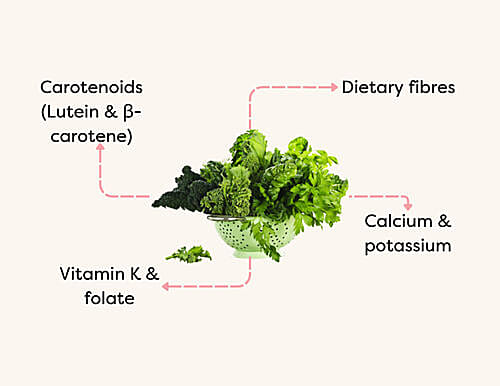Why eat your greens every day
11th Apr 2024
From brain health to heart health, dark leafy greens such as salad greens, kale and spinach, are an essential food to get in your daily meals. Here’s why and our favourite ways to load up on greens!
Key points
3 health benefits of leafy greens
1. Healthy ageing
The evidence keeps piling up that leafy greens can improve many health outcomes. A 2021 umbrella review found that 100 grams of leafy greens per day was linked to a 25% lower risk of death from all causes, including heart disease and stroke.
2. Keep your brain sharp
Adding leafy greens to your plate every day might help protect your memory and thinking skills. Research from Rush University found that people who ate at least one serving of leafy greens daily experienced slower cognitive decline—equivalent to being 11 years younger. Higher intake was also linked to fewer signs of Alzheimer’s disease in the brain.
3. Better muscle function
Daily leafy greens (around 1 cup) are linked to better muscle function, according to the Journal of Nutrition. Even if you’re not hitting the gym, strong muscles are essential for overall health and maintaining bone strength as you age.
Source of
- Nitrate - which helps blood vessels relax, improving blood flow and possibly lowering blood pressure over time.
- Lutein - a type of carotenoid with strong antioxidant and anti-inflammatory properties.
- Folate - a natural form of vitamin B9. It’s critical for producing red blood cells and may influence cancer risk.
- Dietary fibres – essential for effective digestion and to ‘feed’ our gut microbes. Collard greens are one of the highest.
- Minerals and vitamins, especially vitamin K and potassium.
How much?
At least one portion every day, roughly 80g, which is about 4 heaped tablespoons of cooked kale or 2 heaped tablespoons of cooked spinach.

Which greens are best?
- Mix it up: Leafy greens come from edible leaves of all kinds of plants, spanning various botanical families. You’ve got Brassica greens like kale and collard greens, Amaranth greens led by spinach and leaves from the Daisy family like different types of lettuce – each with unique nutrient and flavour profiles. Variety is key!
- The darker the better. A darker green usually indicates a higher amount of phytochemicals with antioxidant properties.
Easy ways to add leafy greens
- Blend them into smoothies with berries, frozen bananas, peanut butter and seeds for all the nutrition without the “green” taste.
- Sauces, soups and stews: Most leafy greens make fantastic pesto bases. You can also finely chop them and throw them in your favourite soups and stews during the last few minutes of cooking.
- With eggs like omelettes and frittatas.
- Salads: If you’re having them raw in a salad, add a flavourful dressing and lots of fun toppings like nuts, seeds, cheese, grains, olives and grilled vegetables.
- Wrap it up – Use large leafy greens like collard greens or Swiss chard as a wrap instead of bread or tortillas. Fill them with your favourite sandwich or taco fillings for a healthy twist.
References/sources
Multiple health outcomes: Morris et al. Neurology. 2018
Cognitive function: Li et al. Food chemistry. 2021
Muscle function: Sim et al. The Journal of nutrition. 2021
